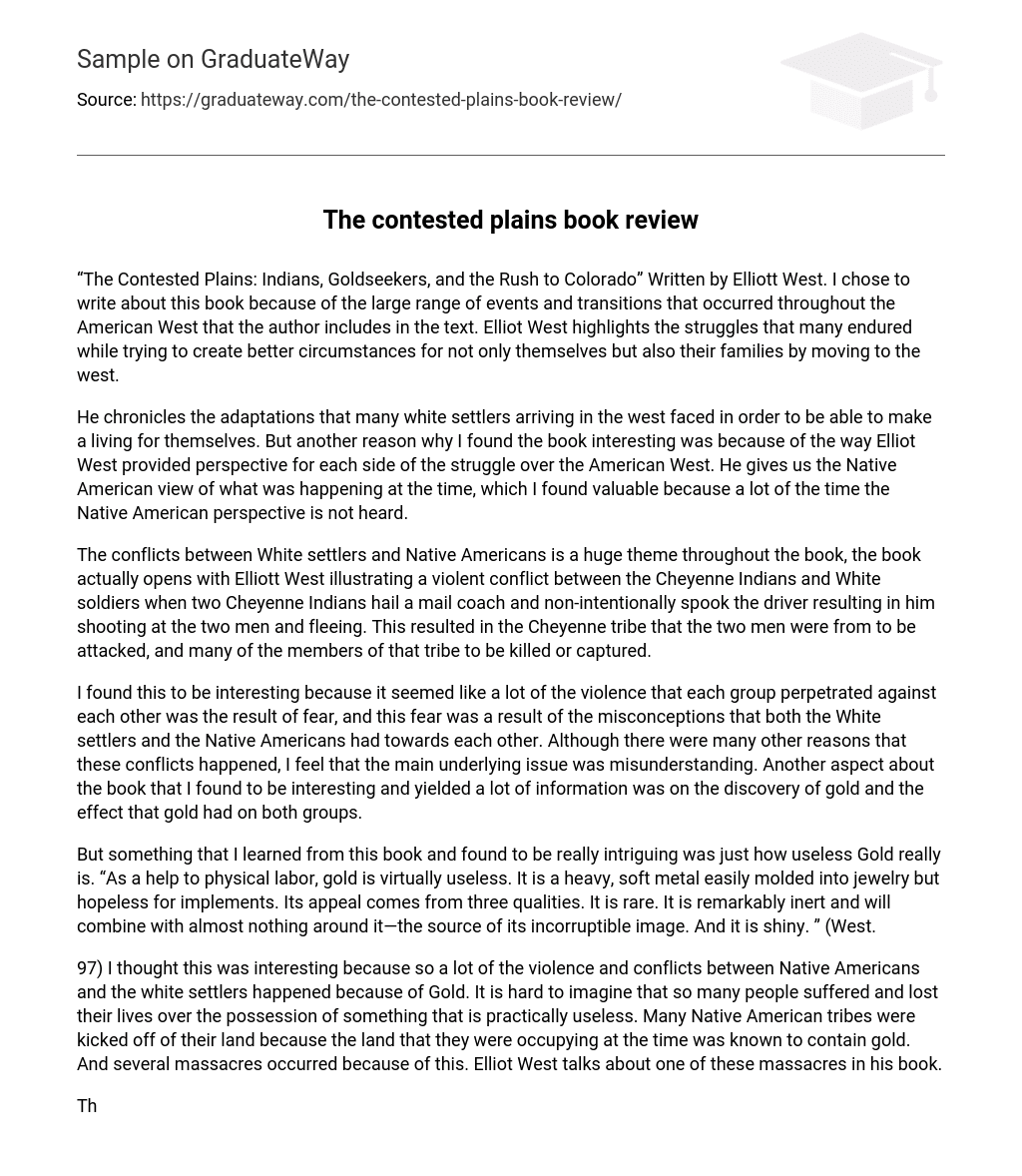“The Contested Plains: Indians, Goldseekers, and the Rush to Colorado” is a book written by Elliott West that delves into the varied events and transformations in the American West. This choice was made because the book examines the challenges faced by people seeking to improve their own lives and those of their families through migration to the western region.
The book documents the adjustments made by white settlers in the west to support their livelihoods. However, what intrigued me was Elliot West’s inclusion of multiple perspectives on the American West conflict. He sheds light on the Native American viewpoint, which is often overlooked.
Throughout the book, the conflicts between White settlers and Native Americans are a prominent theme. The book begins with Elliott West depicting a violent altercation between Cheyenne Indians and White soldiers. In this incident, two Cheyenne Indians accidentally startle the mail coach driver while hailing him, causing him to shoot at them and escape. Consequently, the tribe that these two men belonged to, the Cheyenne tribe, faced an attack, and numerous members of the tribe were either killed or captured.
The text was intriguing as it revealed how fear and misconceptions led to violence between the White settlers and Native Americans. Although other factors contributed to these conflicts, misunderstanding seemed to be the primary issue. Additionally, the book shed light on the impact of the discovery of gold on both groups, offering valuable insights.
However, what I discovered and found fascinating in this book is the utter uselessness of Gold. “As an aid for physical labor, gold is practically worthless. Though it is a dense and malleable metal suitable for making jewelry, it is completely unsuitable for tools. Its allure stems from three characteristics: its rarity, its remarkable resistance to reacting with other substances – which gives it the image of being incorruptible – and its shiny appearance.” (West.
97) The violence and conflicts between Native Americans and white settlers stemmed from the allure of gold, which I find intriguing. It is astonishing to think that countless lives were lost over the possession of something that holds little practical value. Numerous Native American tribes were forcibly displaced from their lands simply because those lands were known to harbor gold. Tragically, several massacres took place as a result. Elliot West addresses one of these massacres in his book.
The Sand Creek Massacre took place on November 29, 1864, when a military force consisting of 700 men from the Third Colorado regiment launched an attack on Cheyenne Indians. Shockingly, the Cheyenne had an American flag displayed at their camp. The military force brutally killed and mutilated approximately 200 men, women, and children. Not only were there ongoing raids and skirmishes between Native Americans and white settlers, but gold also played a significant role in motivating this massacre and other acts of violence against Native Americans.
Elliot West’s book delves into an intriguing aspect – the contrasting weaponry strategies needed in the plains versus woodland areas. Notably, guns illustrate this disparity. In woodland regions, Native Americans and settlers could skillfully camouflage themselves with trees and foliage while hunting. However, on undulating plains, this tactic proved near-impracticable as there was often no natural cover available. Consequently, animals like buffalo possessed the advantage of detecting hunters from afar and thus evading capture before hunters could even close the distance.
However, in battle or a fight, guns proved to be extremely useful. The capability to kill and injure enemies from a greater distance was seen as a pure advantage, especially when the enemy lacked guns or was not as well-armed. Raiders armed with firearms could attack a village from a safe distance, causing havoc without exposing themselves to danger. Even if defenders with firearms were outnumbered, they could keep their foes at bay and relatively powerless while inflicting damage from afar.
The horse plays a significant role throughout the book, particularly in relation to the plains. The plains offer an ideal habitat for horses, and owning them brings multiple benefits. Horses serve as valuable living tools that allow owners to travel longer distances at faster speeds and carry heavier loads. Unlike dogs, horses have a practical advantage in that they do not need to consume other animals for sustenance. This convenience spares their owners from hunting for food specifically for their horses.
Elliot West provides numerous examples of both Native American and settler lifestyles. He details the factors that influenced the development of the West and explores various aspects that impacted the history between Native Americans and Settlers. This includes their tools, the struggle for gold leading to conflicts, and the significant role of horses in the West.
I discovered that this book is highly educational and it reveals insights on topics that I would not have previously considered important. “The Contested Plains: Indians, Goldseekers, and the Rush to Colorado” is a remarkable book for individuals interested in delving deep into the history of how America was formed and the dynamics between Native Americans and pioneers. “I have diligently and ethically created this work and have no knowledge of anyone who hasn’t.”





